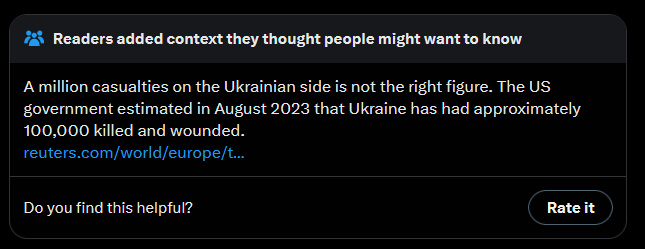Yeah, the whole "you can't have any money, and you also can't leave the country" bit... like just imprison him at that point? How is this in any way meaningfully different from just jailing political dissidents?
Even then, prisoners are at least supposed to be fed by the state (albeit not to a necessarily high standard...), this guy literally has to submit a document to gain permission to buy food?! (https://xcancel.com/hussedogru/status/1925845756927197233)




 ), an F-16's 25k, I'm not finding numbers for the EA-18G Growler but the regular F/A-18 is 19.5k, and obviously these planes, not being strategic bombers, would have flown much shorter missions. There's also various recon and refueling aircraft... let's, just for the sake of a very rough estimate, call it as 118 F-35s (125 - the 7 B-2s, not realistic at all but just to keep it simple), at the lower estimate - that's 3.9 mil per hour, and the actual main portion of the operation, involving all aircraft together, wouldn't have lasted more than a few hours, right? So like, I dunno, 5 hours, like 20 mil? Possibly the cost of just one GBU, depending on which estimate we're going by.
), an F-16's 25k, I'm not finding numbers for the EA-18G Growler but the regular F/A-18 is 19.5k, and obviously these planes, not being strategic bombers, would have flown much shorter missions. There's also various recon and refueling aircraft... let's, just for the sake of a very rough estimate, call it as 118 F-35s (125 - the 7 B-2s, not realistic at all but just to keep it simple), at the lower estimate - that's 3.9 mil per hour, and the actual main portion of the operation, involving all aircraft together, wouldn't have lasted more than a few hours, right? So like, I dunno, 5 hours, like 20 mil? Possibly the cost of just one GBU, depending on which estimate we're going by. , and even North Korea showing up with a little bit
, and even North Korea showing up with a little bit  ).
). )
)

 um actually the US says that only a few Ukrainians have died (based on propaganda fed to them by the Ukrainians)
um actually the US says that only a few Ukrainians have died (based on propaganda fed to them by the Ukrainians)
He has a lawyer who will appeal the decision (and is presumably working pro bono, given that Hüseyin cannot access or receive any money to pay anyone with...) and is planning on suing the European Commission - but there is no clear timeframe on a response by the Commission (see from this timestamp: https://www.youtube.com/live/MZ0l78jIg3U?t=1711).
So I guess theoretically they could just drag this out for years - and, given that he's legally forbidden from holding a job and earning any more money than what he had at the start of the sanctions, and anyone sending him money or food could also be sanctioned... he and his family would eventually just straight up starve to death? Like I genuinely still can't grasp the absolute insanity of the way these sanctions work, we're not talking about some corporate entity here, this is one guy who's just... not allowed to have money anymore?!